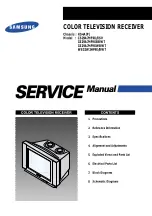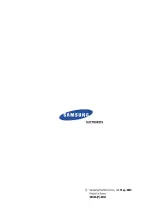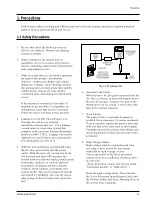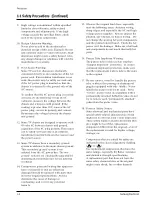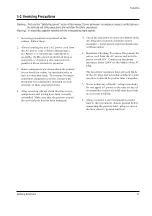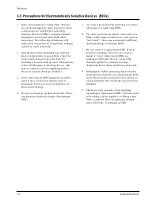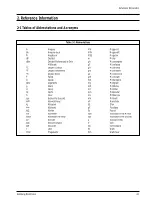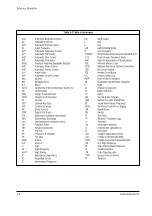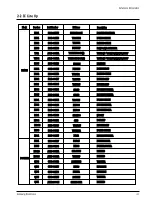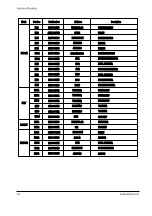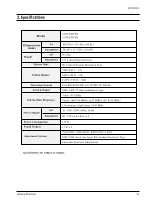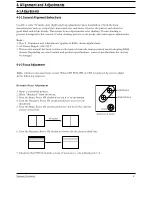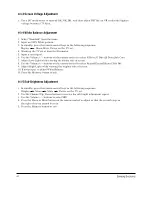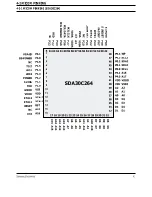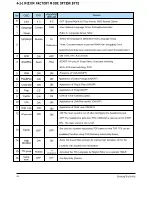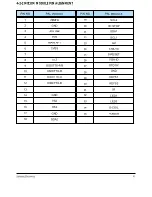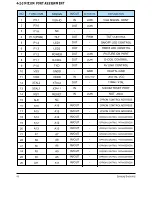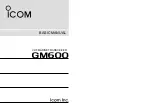
1. Precautions
1-1 Safety Precautions
1. Be sure that all of the built-in protective
devices are replaced. Restore any missing
protective shields.
2. When reinstalling the chassis and its
assemblies, be sure to restore all protective
devices, including: nonmetallic control knobs
and compartment covers.
3. Make sure that there are no cabinet openings
through which people—particularly
children—might insert fingers and contact
dangerous voltages. Such openings include
the spacing between the picture tube and the
cabinet mask, excessively wide cabinet
ventilation slots, and improperly fitted back
covers.
If the measured resistance is less than 1.0
megohm or greater than 5.2 megohms, an
abnormality exists that must be corrected
before the unit is returned to the customer.
4. Leakage Current Hot Check (Figure 1-1):
Warning: Do not use an isolation
transformer during this test. Use a leakage-
current tester or a metering system that
complies with American National Standards
Institute (ANIS C101.1, Leakage Current for
Appliances), and Underwriters Laboratories
(UL Publication UL1410, 59.7).
5. With the unit completely reassembled, plug
the AC line cord directly into the power
outlet. With the unit’s AC switch first in the
ON position and then OFF, measure the
current between a known earth ground (metal
water pipe, conduit, etc.) and all exposed
metal parts, including: antennas, handle
brackets, metal cabinets, screwheads and
control shafts. The current measured should
not exceed 0.5 milliamp. Reverse the power-
plug prongs in the AC outlet and repeat the
test.
Fig. 1-1 AC Leakage Test
6. Antenna Cold Check:
With the unit’s AC plug disconnected from the
AC source, connect an electrical jumper across
the two AC prongs. Connect one lead of the
ohmmeter to an AC prong. Connect the other
lead to the coaxial connector.
7. X-ray Limits:
The picture tube is especially designed to
prohibit X-ray emissions. To ensure continued
X-ray protection, replace the picture tube only
with one that is the same type as the original.
Carefully reinstall the picture tube shields and
mounting hardware; these also provide X-ray
protection.
8. High Voltage Limits:
High voltage must be measured each time
servicing is done on the B+, horizontal
deflection or high voltage circuits.
Correct operation of the X-ray protection
circuits must be reconfirmed whenever they
are serviced.
(X-ray protection circuits also may be called
“horizontal disable” or “hold-down”.)
Heed the high voltage limits. These include
the X–ray Protection Specifications Label, and
the Product Safety and X-ray Warning Note on
the service data schematic.
Precautions
Samsung Electronics
1-1
LEAKAGE
CURRENT
TESTER
DEVICE
UNDER
TEST
TEST ALL
EXPOSED METAL
SURFACES
3-WIRE CORD
ALSO TEST WITH
PLUG REVERSED
(USING AC ADAPTER
PLUG AS REQUIRED)
EARTH
GROUND
(READING SHOULD
NOT BE ABOVE
0.5mA)
Follow these safety, servicing and ESD precautions to prevent damage and protect against potential
hazards such as electrical shock and X-rays.
Summary of Contents for CS29A7HF9X/XSV
Page 2: ...ELECTRONICS Samsung Electronics Co Ltd May 2001 Printed in Korea 3KS4A P 2910...
Page 12: ...3 2 Samsung Electronics MEMO...
Page 36: ...4 24 Samsung Electronics MEMO...
Page 89: ...Samsung Electronics 7 Block Diagrams 7 1 Voltage Current Block...
Page 96: ...Schematic Diagrams 8 4 Samsung Electronics 8 3 MAIN 3 3 RCA Power Line Signal Line...
Page 98: ...8 5 MAIN 2 3 SCART Schematic Diagrams 8 6 Samsung Electronics TP19 TP20 TP21 TP19 TP20 TP21...
Page 99: ...Samsung Electronics 8 6 MAIN 3 3 SCART Schematic Diagrams 8 7...
Page 100: ...Schematic Diagrams 8 8 Samsung Electronics 8 7 MICOM...
Page 103: ...Samsung Electronics Schematic Diagrams 8 11 8 9 CRT SIDE A V CRT SIDE AV...
Page 104: ...Schematic Diagrams 8 12 Samsung Electronics 8 10 DOLBY...
Page 105: ...Samsung Electronics 8 11 F BOX 1 3 Schematic Diagrams 8 13...
Page 106: ...8 12 F BOX 2 3 Schematic Diagrams 8 14 Samsung Electronics...
Page 107: ...Samsung Electronics 8 13 F BOX 3 3 Schematic Diagrams 8 15...

